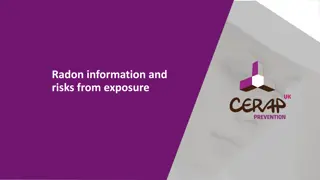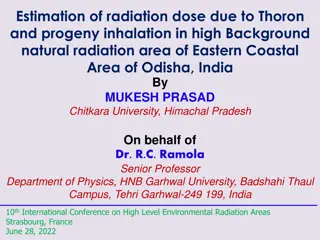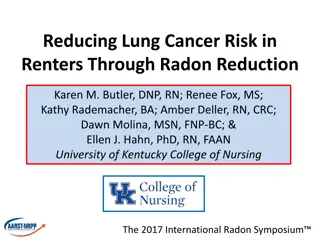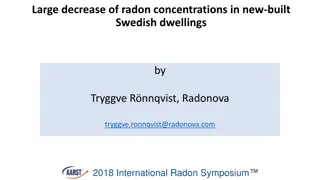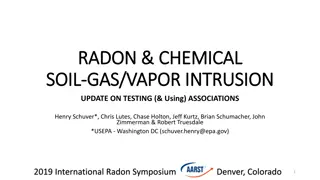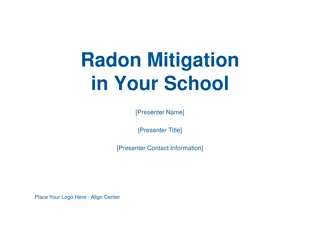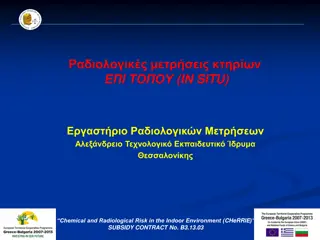Understanding Radon: Risks, Testing, and Prevention in Schools
Radon is a colorless, odorless, and tasteless radioactive gas that poses serious health risks, including lung cancer. This presentation covers the basics of radon, its entry into buildings, factors affecting its levels, and why it's a significant problem. Learn how to test for radon in schools and understand the environmental factors influencing radon levels. Take steps to prevent radon exposure and protect the health of students and staff.
Download Presentation

Please find below an Image/Link to download the presentation.
The content on the website is provided AS IS for your information and personal use only. It may not be sold, licensed, or shared on other websites without obtaining consent from the author. Download presentation by click this link. If you encounter any issues during the download, it is possible that the publisher has removed the file from their server.
E N D
Presentation Transcript
Radon Basics & Testing in Your School [Presenter Name] [Presenter Title] [Presenter Contact Information] Place Your Logo Here - Align Center
What is radon? Radioactive gas Colorless, odorless, tasteless Occurs naturally, decay product of uranium Found all over the world Can cause lung cancer Image Source: http://www.technology.org/2013/05/31/how-old-is-the-earth/ 2
Image Source: Testing for Elevated Radon in Schools: A Protocol and Plan 3
How does radon enter a building? 1. Cracks in solid floors 2. Construction joints 3. Cracks in walls 4. Gaps in suspended floors 5. Gaps around pipes 6. Cavities inside walls 7. Water supply Image Source: www.epa.gov/radon 4
Other Routes of Entry HVAC systems Diffusion Well water Building materials 5
Level of Radon Depends on: Underlying geology Soil permeability Openings in the building How air is transported within a building Ventilation rate Difference in air pressure 6
Vacuum Effect Image Source: Testing for Elevated Radon in Schools: A Protocol and Plan 7
Environmental Factors Image Source: Testing for Elevated Radon in Schools: A Protocol and Plan 8
Why is radon a problem? Group A carcinogen known cancer causing substance 2nd leading cause of lung cancer, after smoking Combined with smoking 10x the risk No immediate health effects Image Source: CDC Radon Toolkit for Public Health Professionals 9
Cancer Types and Estimated U.S. Deaths, 2015 Image Source: Testing for Elevated Radon in Schools: A Protocol and Plan 10
How does radon cause lung cancer? When you breathe in radon gas, the radioactive particles can get trapped in your lungs. Over time, they cause lung cancer. The risk from radon depends on two things: How much: High radon levels are more dangerous How long: The more contact you have with radon gas, the greater your risk. 11
Where do we spend our time? EPA shows that we spend 87.9% of our time indoors on a daily basis. Home is likely the most significant source of radon exposure School is the second largest contributor for most school children and staff *Source: U.S. Environmental Protection Agency Image Source: CDC Radon Toolkit for Public Health Professionals 12
Who Should Test for Radon? The EPA and Oregon Health Authority (OHA) recommend that every home and school be tested for radon. 13
Oregon Law Radon in Schools ORS 332.166-167 OHA to give radon info to each school district School districts required to submit testing plans by September 2016 and perform initial testing before January 1, 2021 14
Radon in U.S. Schools Background EPA began investigating radon in schools in 1988 Initial studies showed elevated levels of radon in every state National School Radon Survey 19.3% (1 in 5) of U.S. schools have at least one frequently occupied room greater than 4.0 pCi/L EPA estimate 70,000 schoolrooms affected in U.S. 15
How is radon measured? Radon is measured in Picocuries per Liter (pCi/L) EPA recommends taking corrective action if levels are 4 pCi/L or above No safe level of radon exposure 16
Type of Radon Measurement Devices 1. Passive (recommended for school district initial testing) Short-term Long-term Active Continuous radon monitors (CRM) 2. 17
Short- and Long-term Tests Long-term Long Low cost Simple More likely to represent school year average Not as sensitive Does not require close- building conditions Short-term Quick Low cost Simple Practical Sensitive to temperature and humidity Require closed-building conditions 18
Radon in [insert school or district name] Background [If your school or district has implemented radon testing/mitigation practices in the past, please use this slide to summarize those details] 19
Current Radon Testing in Your School [Insert school or district name] will begin testing on [insert date]. Small devices will be placed in each of the frequently occupied rooms that are in contact with the ground starting [insert date] Includes classrooms, offices, conference rooms, computer rooms, gymnasiums, auditoriums, cafeterias and breakrooms Does not include storage rooms, kitchens, bathrooms, stairways, hallways or elevator shafts Test devices are not dangerous in any way Initial tests will be short-term and last between 2 and 7 days These devices will be picked up on [insert date] 20
Testing Devices The testing devices will look like [describe testing device] Ex. A small black cylinder (also known as an alpha track) about 1-1/2 to 2 inches across Ex. A hanging cardboard envelop packet (charcoal absorption) [Insert device photo] See sample photos on next slide 21
(Delete slide after choosing sample photo) Activated charcoal absorption devices Image Source: Image Source: http://aarst-nrpp.com/wp/consumer-devices/ http://www.ewashtenaw.org/government/departments/environme ntal_health/indoor_air/radon/eh_radon.html Electret-ion chamber (EIC) Alpha track detector Continuous radon monitor (CRM) 22
[Insert school or district name] Radon Test Results Will be available on the [insert school or district name] website within [timeframe; i.e. 5 days] of receiving initial test results [insert web link where test results will be located] Follow up testing will be done in every room where any initial test results are 4 pCi/L or greater If any follow up test results are 4 pCi/L or above, mitigation is recommended 23
Is Mitigation Needed? Mitigation is any system or steps designed to reduce the radon level in the indoor air of a building While ORS 332.166-167 does not specifically require mitigation of elevated radon in schools, both EPA and OHA strongly suggest that rooms with follow-up measurements above 4.0 pCi/L be mitigated It is likely impossible to reduce a school s radon level to zero; the goal of radon reduction is harm reduction 24
Types of Mitigation Systems Soil depressurization Building pressurization HVAC system adjustments Sealing entry routes Zone-specific ventilation 25
What can YOU do? Test your own home You can find do-it-yourself test kits at: Local hardware stores The American Lung Association www.lung.org/radon; 503-718-6141 National Radon Program at Kansas State University www.sosradon.org; 1-800-SOS-RADON Oregon Radon Awareness Program offers free test kits contact radon.program@state.or.us to find out if you are eligible Encourage students, co-workers, neighbors and others to test their homes 26
Watch Eddies Story https://www.youtube.com/watch?v=WcvoZ1pP3ak 27
Resources [insert school or district contact name and information, such as the health and safety coordinator] Oregon Radon Awareness Program www.healthoregon.org/radon; 971-673-0440 Environmental Protection Agency (EPA) www.epa.gov/radon National Radon Program at Kansas State University www.sosradon.org; 1-800-SOS-RADON 28


